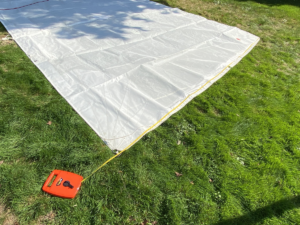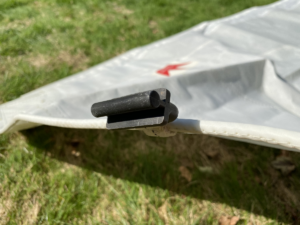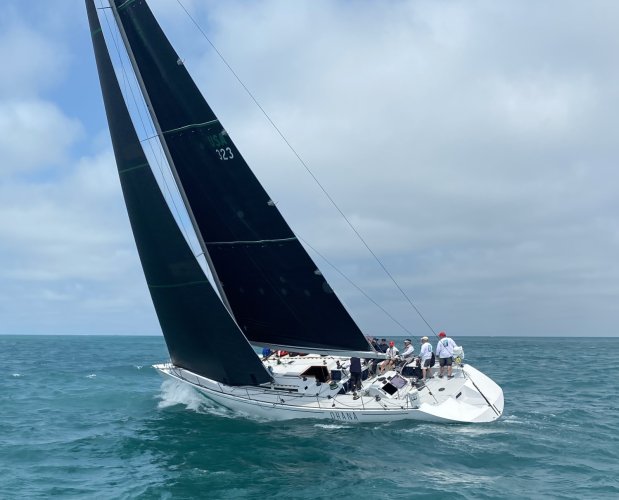Measuring for a new mainsail can seem daunting, as a lot is at stake, and one little error can result in a lot of wasted money and delay you from getting out on the water. But luckily for you, taking measurements onboard your sailboat for a new mainsail is not at all very complicated, and by following this short and comprehensible guide, you are guaranteed to get a mainsail that fits your boat perfectly.
In this article, I will share with you how to measure your sailboat for a new mainsail with only a few measurements. These simple measurements can be given to the sailmaker and from that, he will be able to make a sail that fits your boat perfectly, ensuring your ultimate sailing performance and happy days on the water
3 Ways to get the Dimensions for your New Mainsail
Measure twice, cut once as they say, and it is a good idea to use all 3 methods of measuring to ensure that you get the dimensions just right. The more references the sailmaker has, the more likely you are to get a perfectly fitted mainsail.
Get the Rigs Specs from your boat’s Manufacturer
One of the great advantages of owning a production boat is that fitting new things, such as sails, are incredibly simple. Just refer to your manufacturer’s rigging specs and note the I, P, J, and E measurements for your specific boat model. Make sure that your rig is the original rig for that boat type. However, if your rig has been modified, these specs might not be the right ones, in which case, you will rely on getting rounds 2 and 3 right.

Measure your existing Mainsail
Secondly, you can take the dimensions of your old mainsail. This is a safe way for the sailmaker to make a sail that will be a perfect replacement for your old sail. And even if you do want adjustments made to improve the mainsail, for example by adding more roach or extra luff length, having the measurement from the old sail, is a good point of reference for your sailmaker to work off. You can get your old sail dimensions by taking these 3 measurements:
Luff (leading edge of the mainsail)
Leech (the aft edge of the mainsail)
Foot (The bottom edge of the mainsail)
Measure your Sailboat
The last, and perhaps most important measurements, will be taken onboard your boat, following the steps drawn out below. The best way of making sure these measurements are exact is by taking them using a ‘Surveyor tape measure’, as it is long enough to take each measurement in one go.
Step 1) Measure the Mx Luff Length
The first measurement is the maximum luff length, the edge of the sail that runs up along the mast. This is best done by hoisting a long tape measure up the mainsail halyard, making sure it gets all the way to the top, and keeping the tape measure tight when taking the measurement at the top of the boom.
Step 2) Measure Your Leech
While your tape measure is still hoisted up the mast, swing it back to the aft end of the boom and measure to the point where you want the clew ring to be located.
Step 3: Measure the Max Foot Length
The third measurement measures the maximum foot length. It is taken along the top of the boom, from the aft of the mast to the point of the longest outhaul setting.
While you are at it, take one more measurement, keeping the end of the tape measure at the aft of the mast and measure to the backstay. This will help your sailmaker determine your sails max roach. (Extra roach is a good way of adding extra sail area to your mainsail and can greatly advance your sailing performance.)
Step 4: Boom Measurements
Measure the Tack Pin position: Measure from the back of the mast to the center of the tack pin, then measure from the boom to the center of the tack pin.
Measure the Reef Hook position: This measurement will help your sailmaker determine how to align the reefing rings to hook onto the reef hook. Measure from the back of the mast to the center of the reef hook, then measure from the top of the boom to the center of the reef hook.
Outhaul attachment: Does your boom have an Outhaul Car? If so, measure from the top of the boom to the center of the clew pin in the outhaul car. If on the other hand, you have a shackle on your out-haul, this measurement is not necessary.

Step 5: Luff and Foot Hardware
Next, you need to measure the mast and boom track and note what type of slides are used.
Inform your sailmaker of what type of hardware is used: Internal flat slides, internal round slides, external track or bolt rope.
- Measure the width of your mast luff slides or bolt rope diameter.
- Measure the width of your boom luff slides.
If you do not have an existing mainsail to refer to, you will have to measure the track of your mast and boom instead, to determine what type of slides, slugs, or bolt rope to use.
Step 6: Mast Rake and Mast Bend
The last things that a sailmaker will need to know is the mast rake and mast bend. Your sailmaker might be able to pull off these dimensions from a picture of your boat’s profile, but this is something you will have to discuss directly with them.
The other way to measure the rake and bend is by using a plum bob.
Step 7: Last Sail Options
Now it is time for the final details, which will ensure that you get a mainsail that you can be perfectly happy with.
How many reefs do you want in your mainsail?
The typical cruising mainsail configuration has 2 reef points placed at intervals of approximately 12 percent of the luff length. But if you plan to sail in very heavy conditions or are preparing for a longer voyage where there is a chance of encountering storms, you might want to add a third reef
How many full battens do you want in your mainsail?
What type of battens, how many, and where they should be positioned are a continuous cause for debate among sailors. Some prefer a fully battened sail, some like partial battens, some swear by a combination of the two and some prefer no battens at all. If you are unsure of what batten configuration is right for you, you can read about the different options and their pros at: ‘Why the Right Battens are Important for Mainsail Efficiency’
Do you want a Cunningham?
The Cunningham is an important mechanism with new sails in racing when sail trimming is imperative. But it is also a great device for long-term cruisers to help with correcting the shape of older sails where perfect sail shape has been lost.
Do you want an insignia or sail number?
The insignia is a great way to add a personal touch or even advertise your business or blog.
The Measurements have been Taken, What’s Next?
Once you have taken all the above measurements and noted the details for your new sail, submit your details for a new sail quote through SailTrader. But there is one more thing that is worth considering before you give him the green light. What sailcloth material should you use for your new mainsail?
The market is diverse, and there are many different types of sailcloth available on the market, to suit all kinds of different boats and sailing applications. Discuss the options with your sailmaker, to find the cloth that will suit your needs the best.
To get a better understanding of the different mainsail materials available on the market and which will suit your specific boat and sailing application best, check out A Guide to Sailcloth Material for Mainsails and Headsails.

